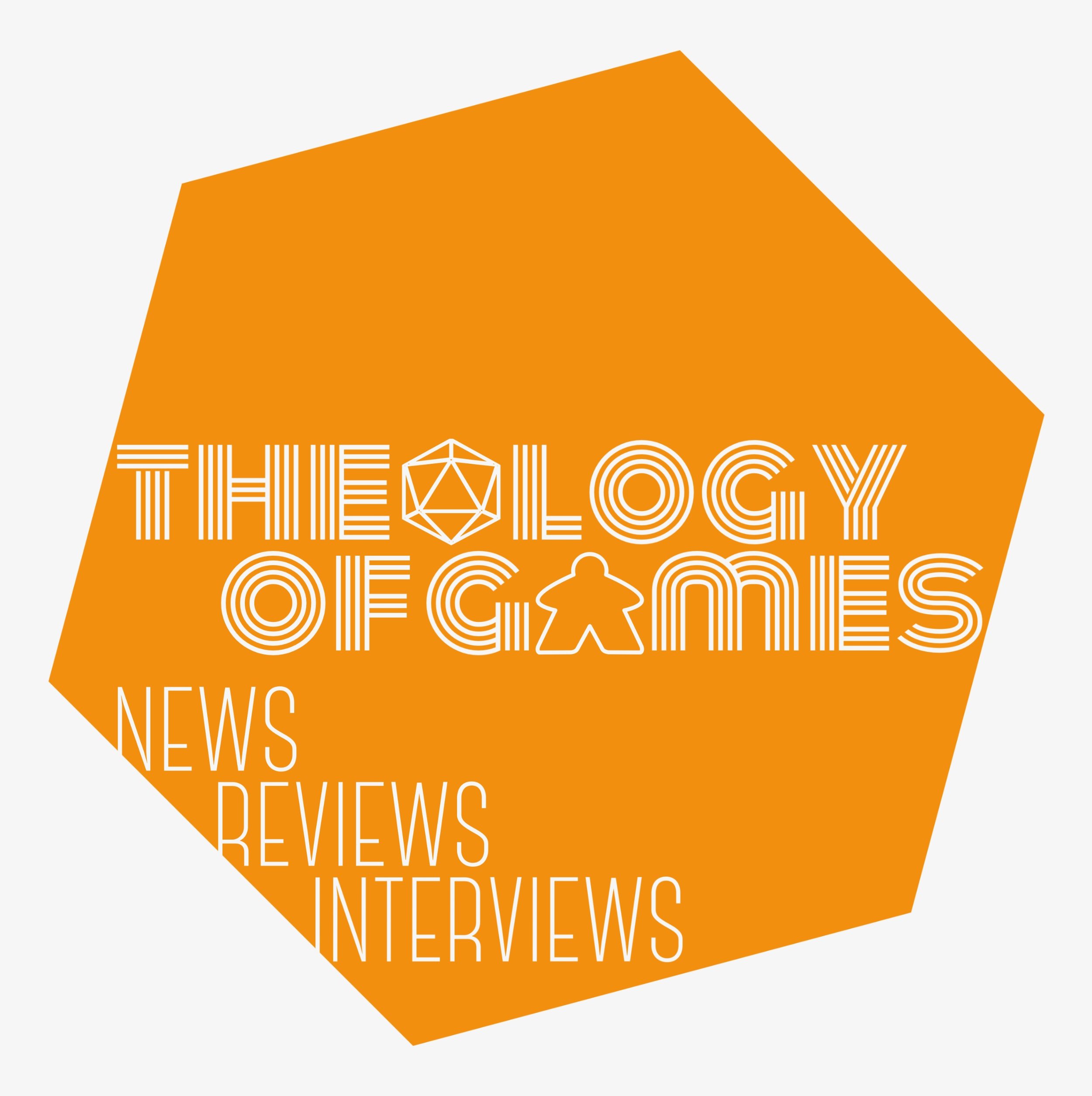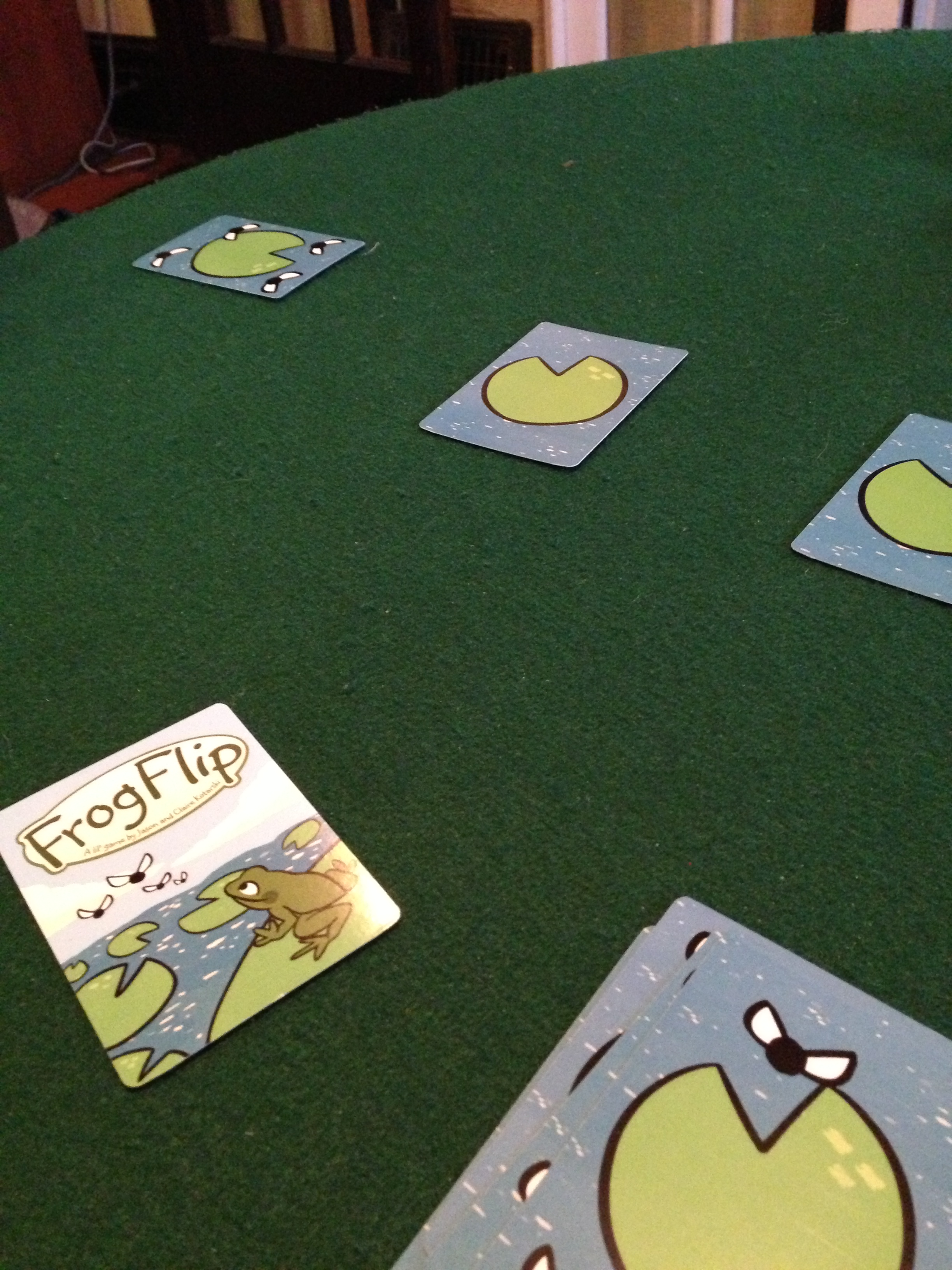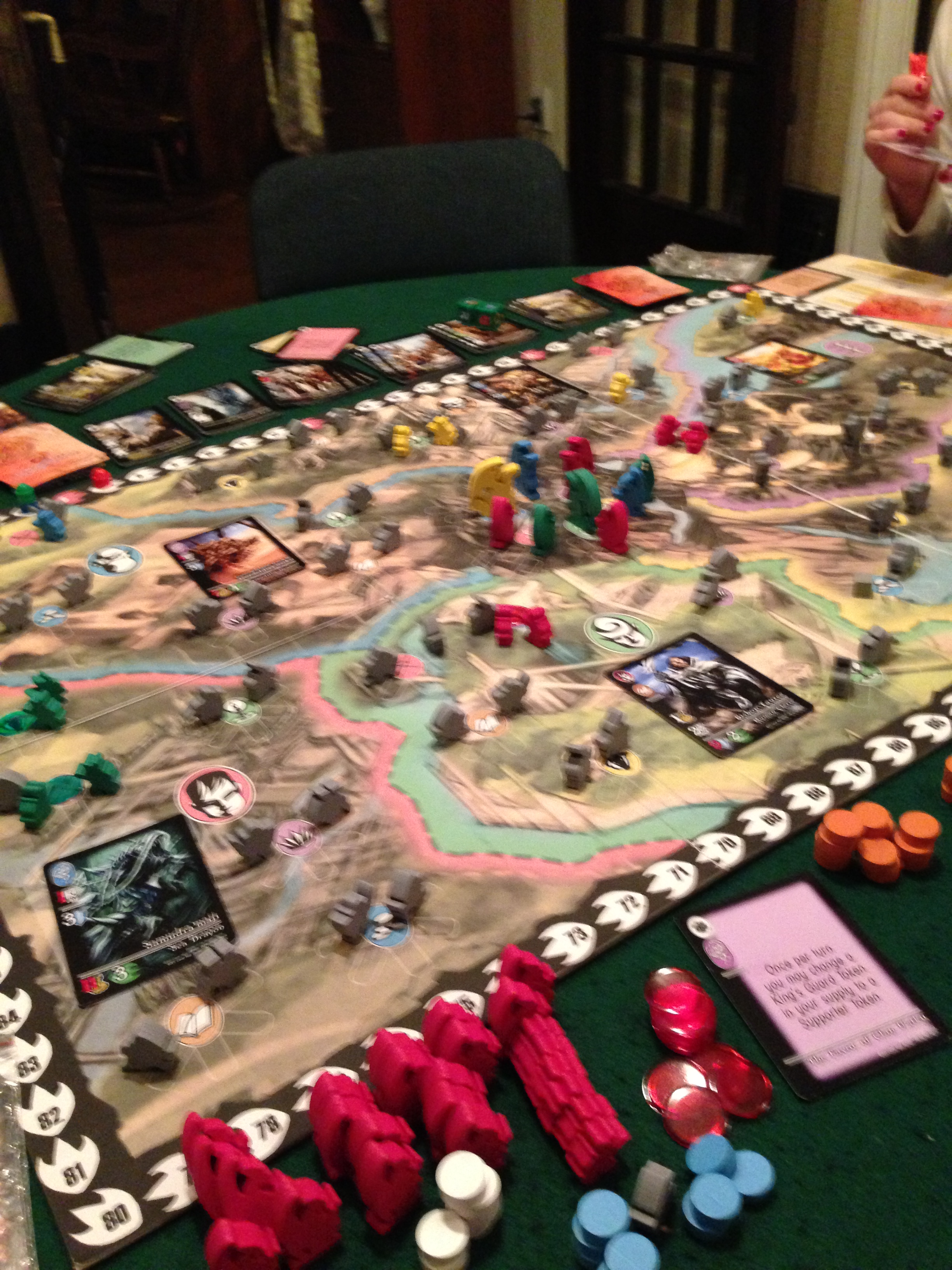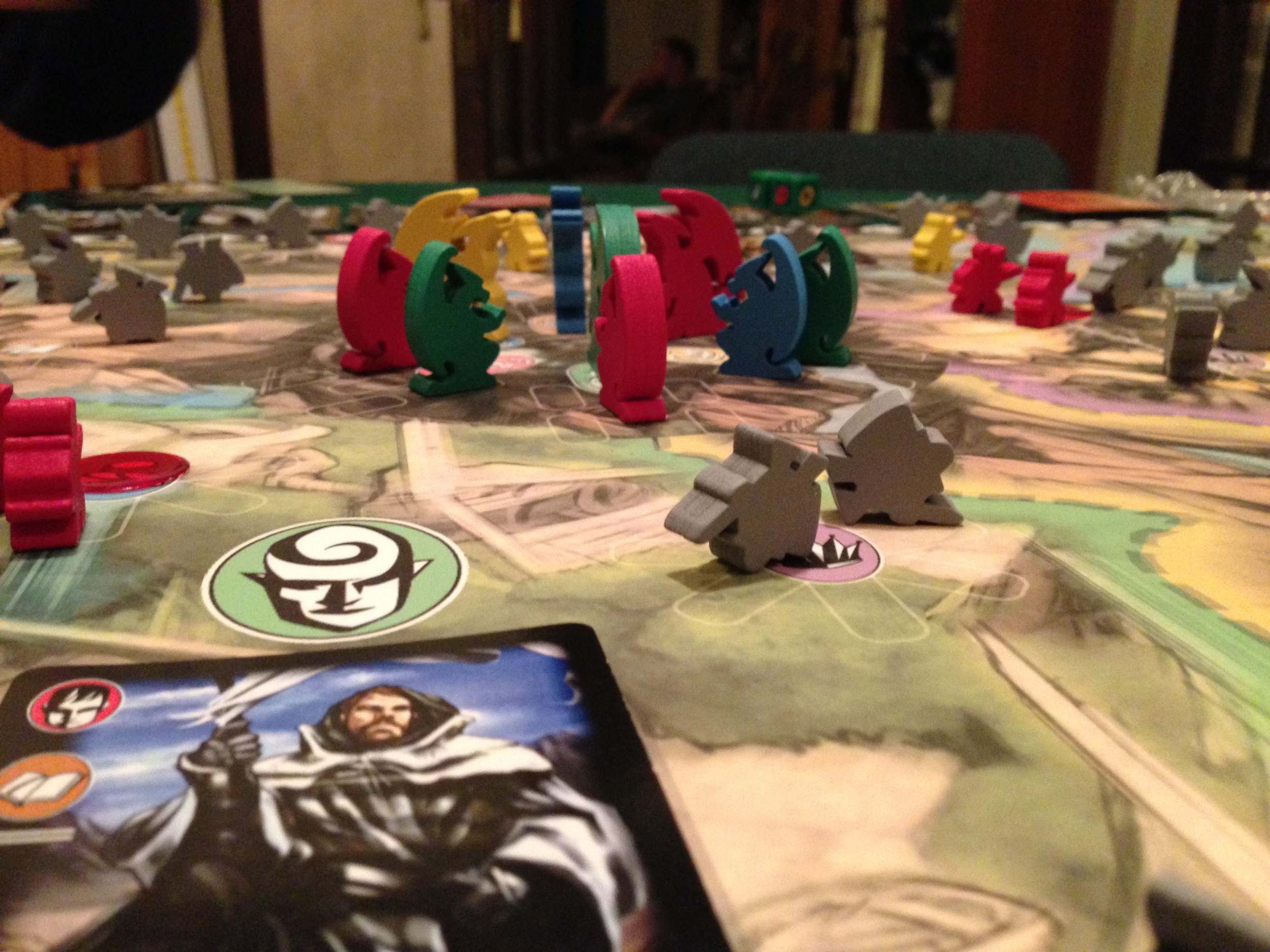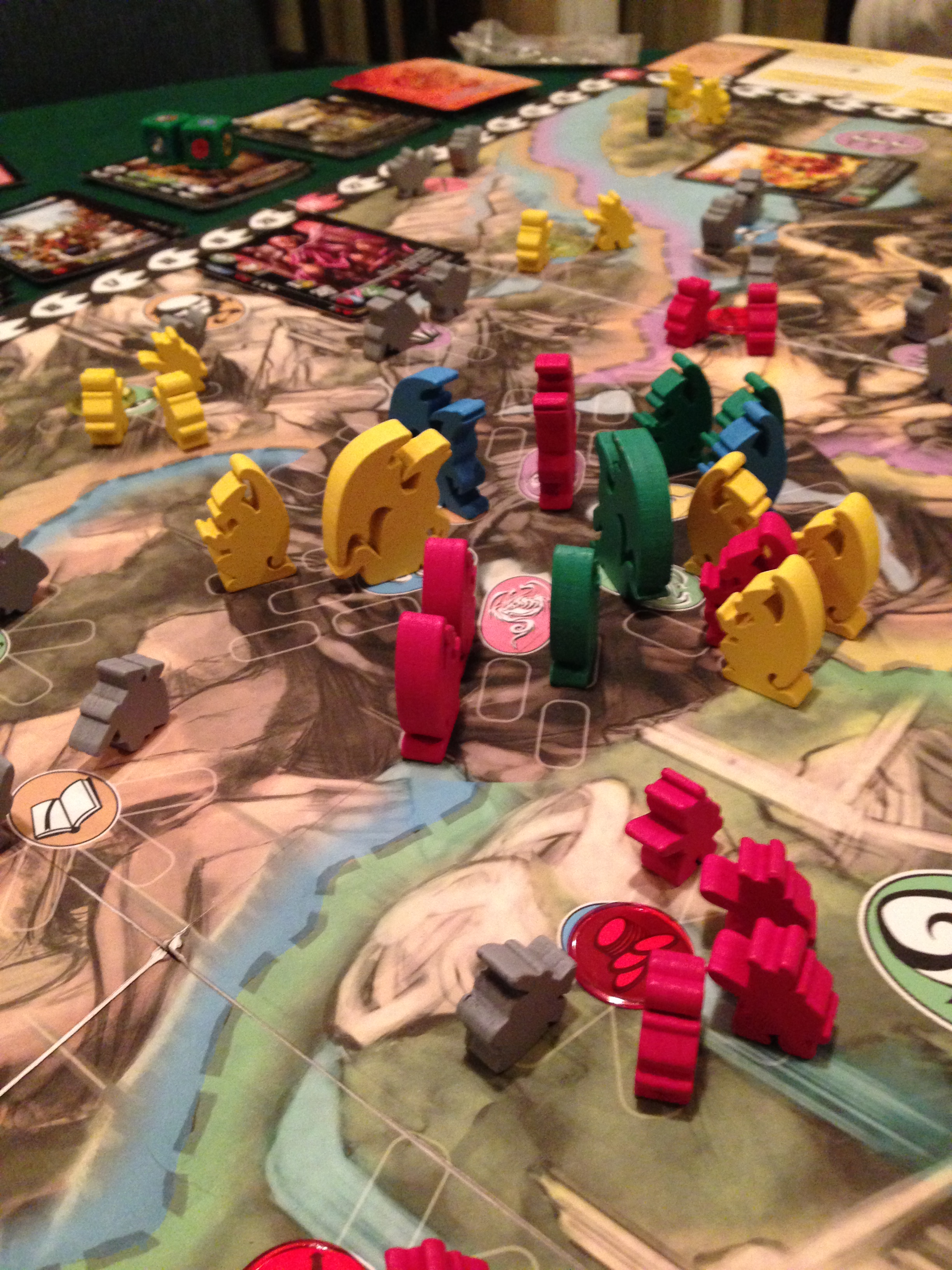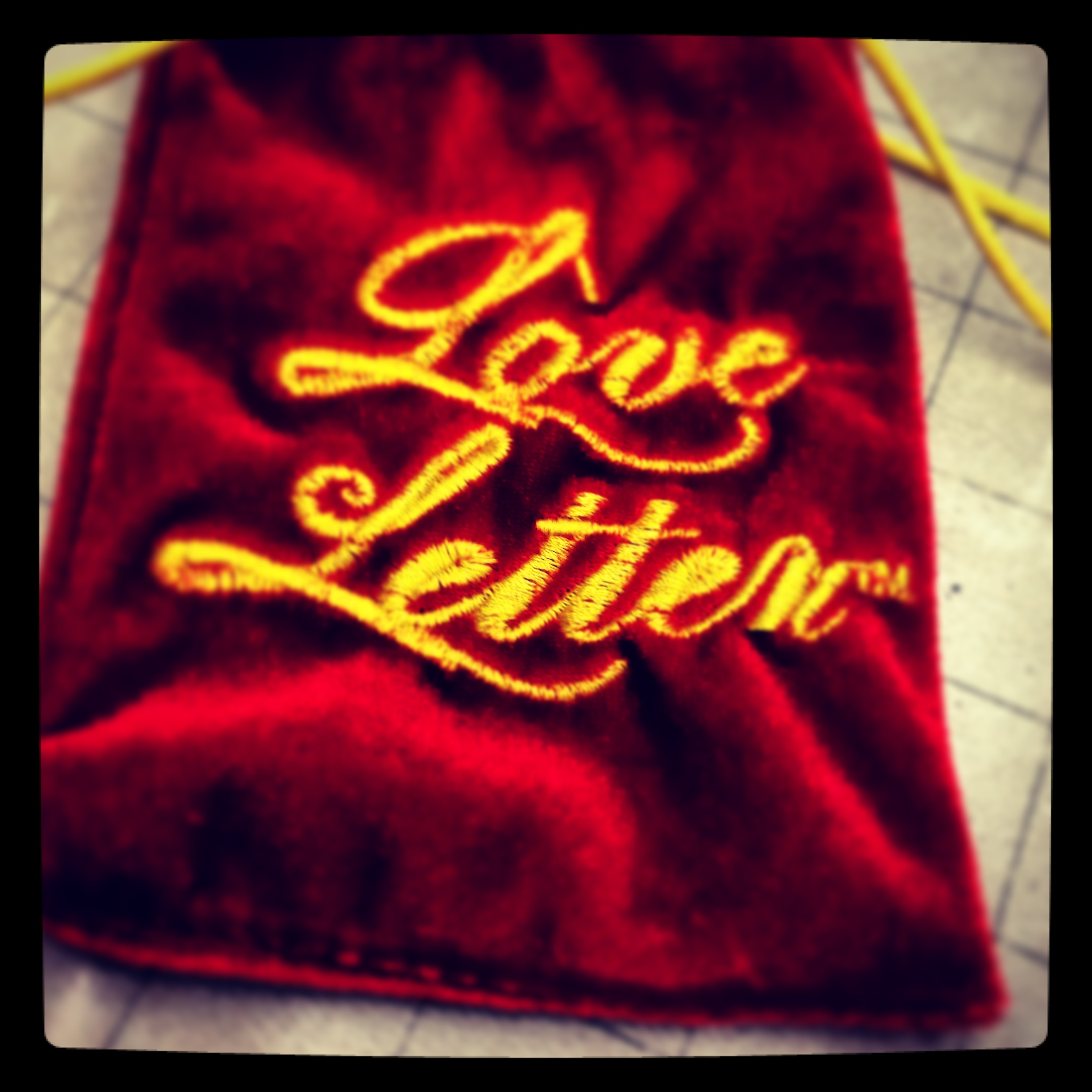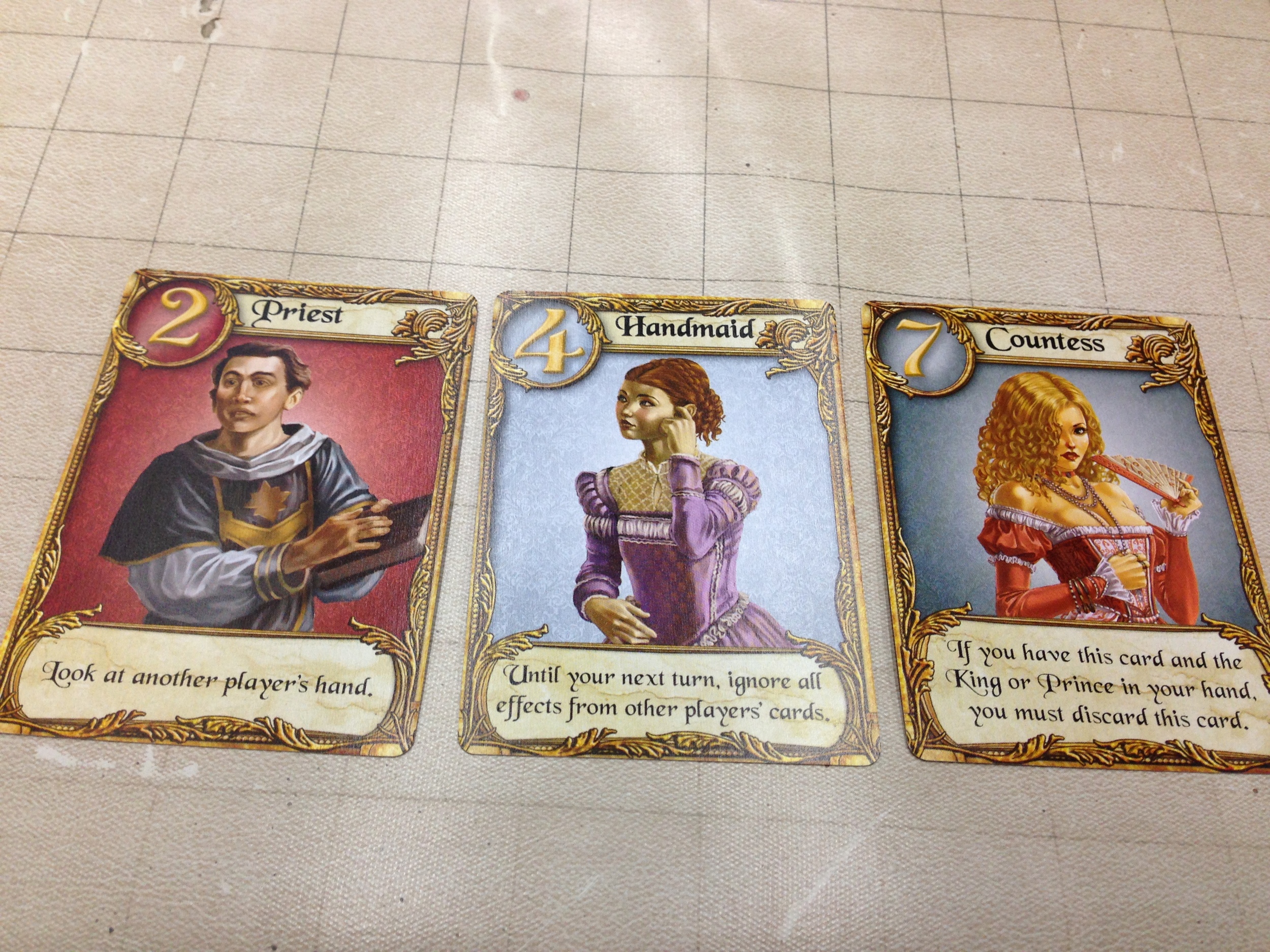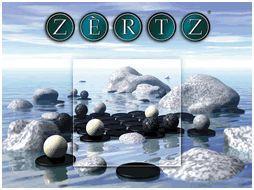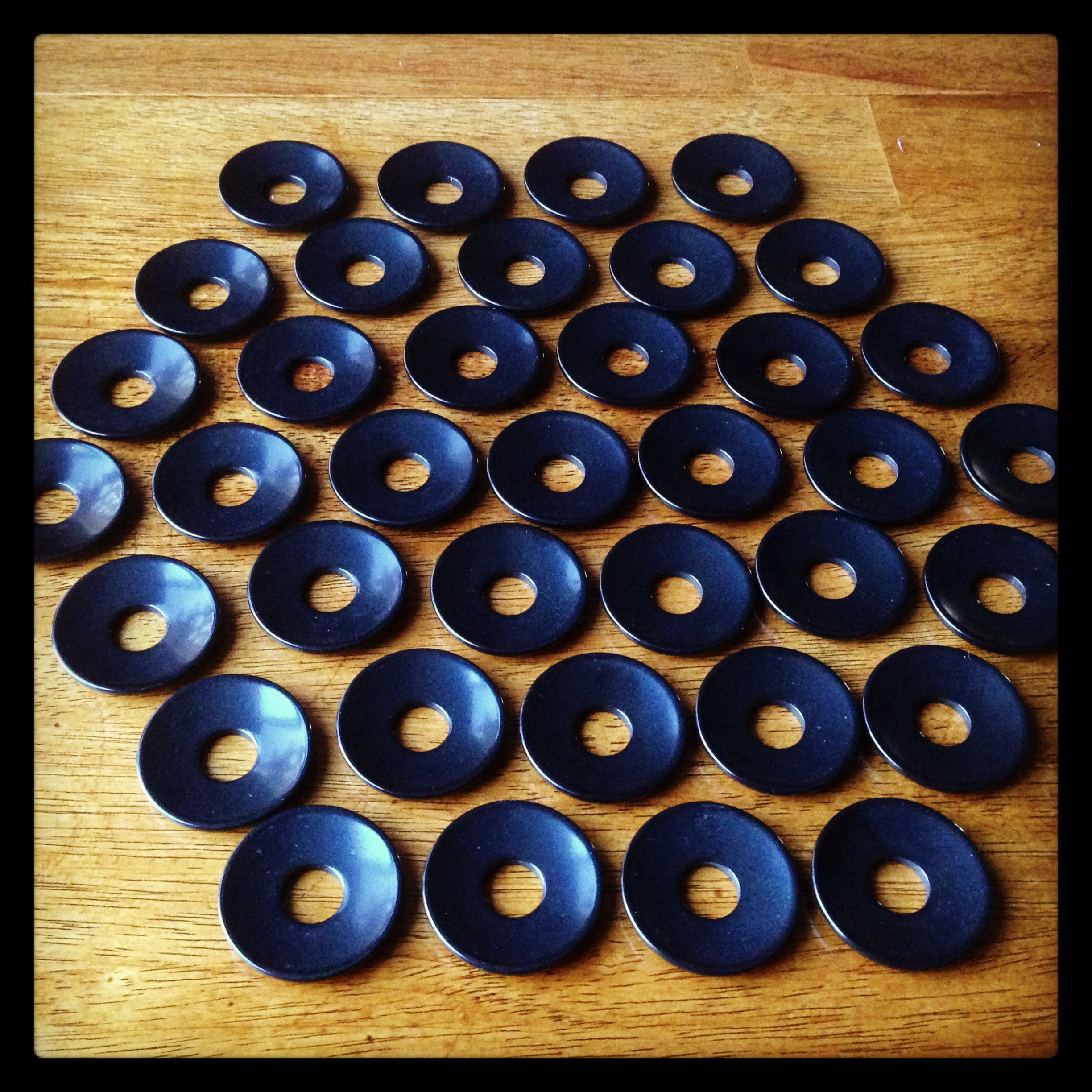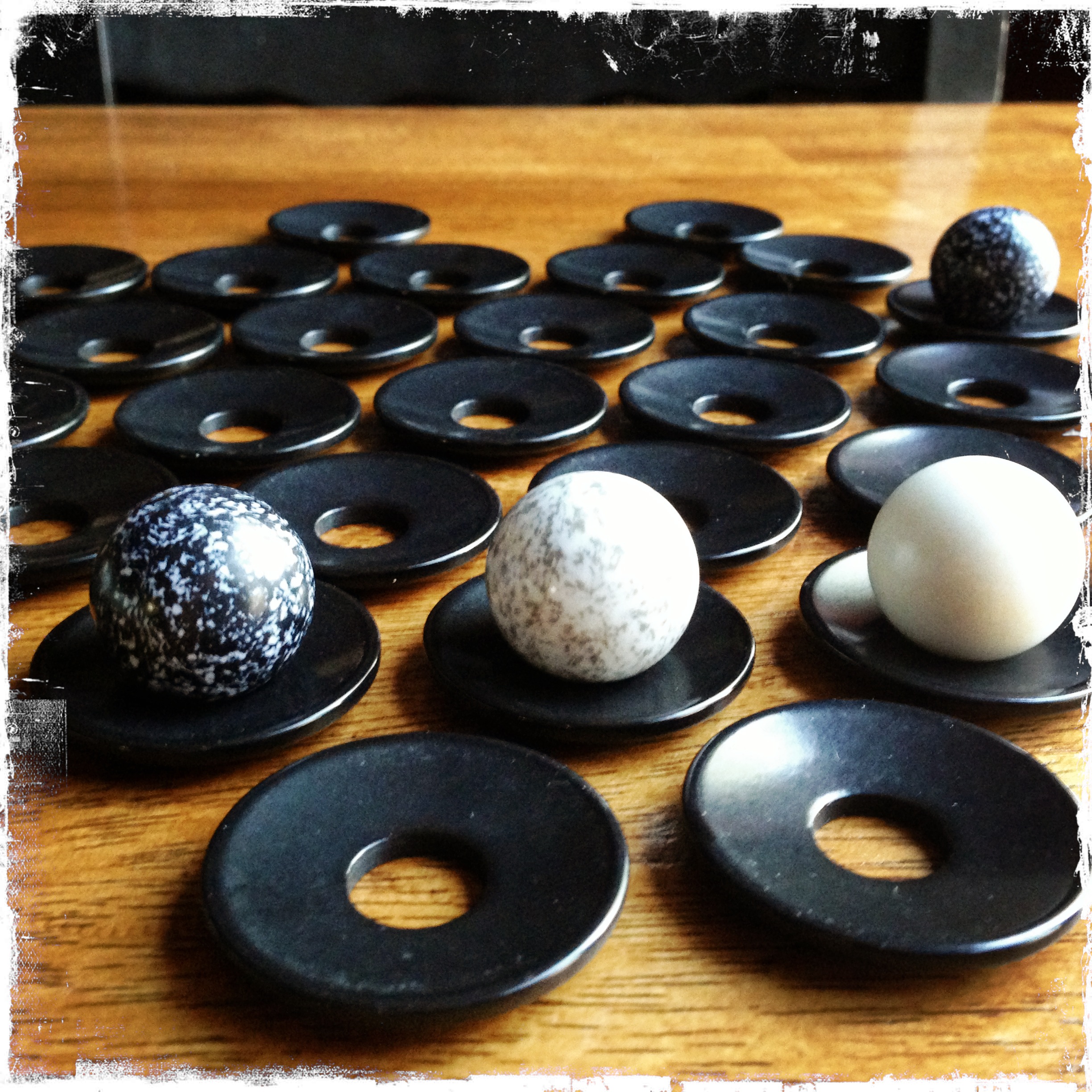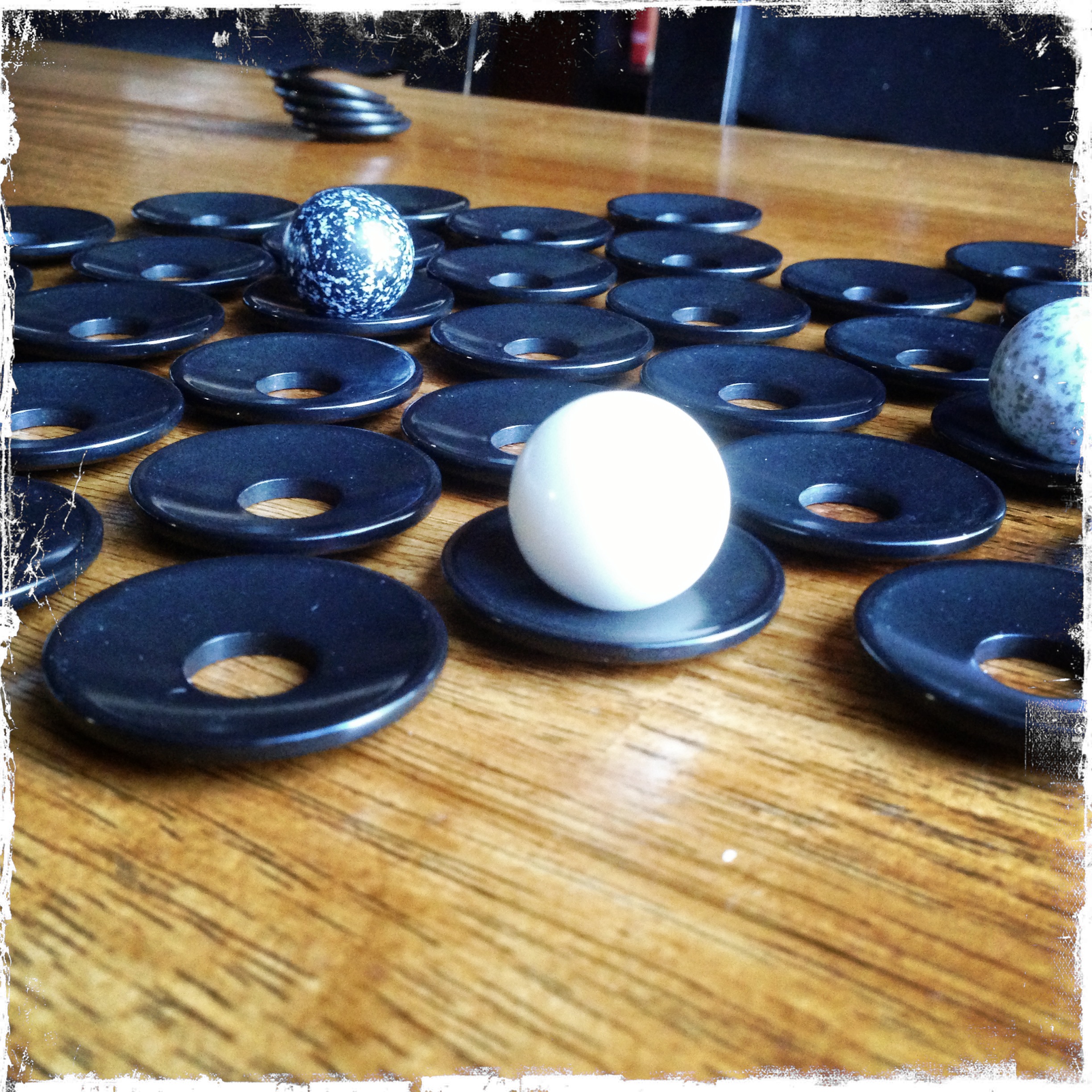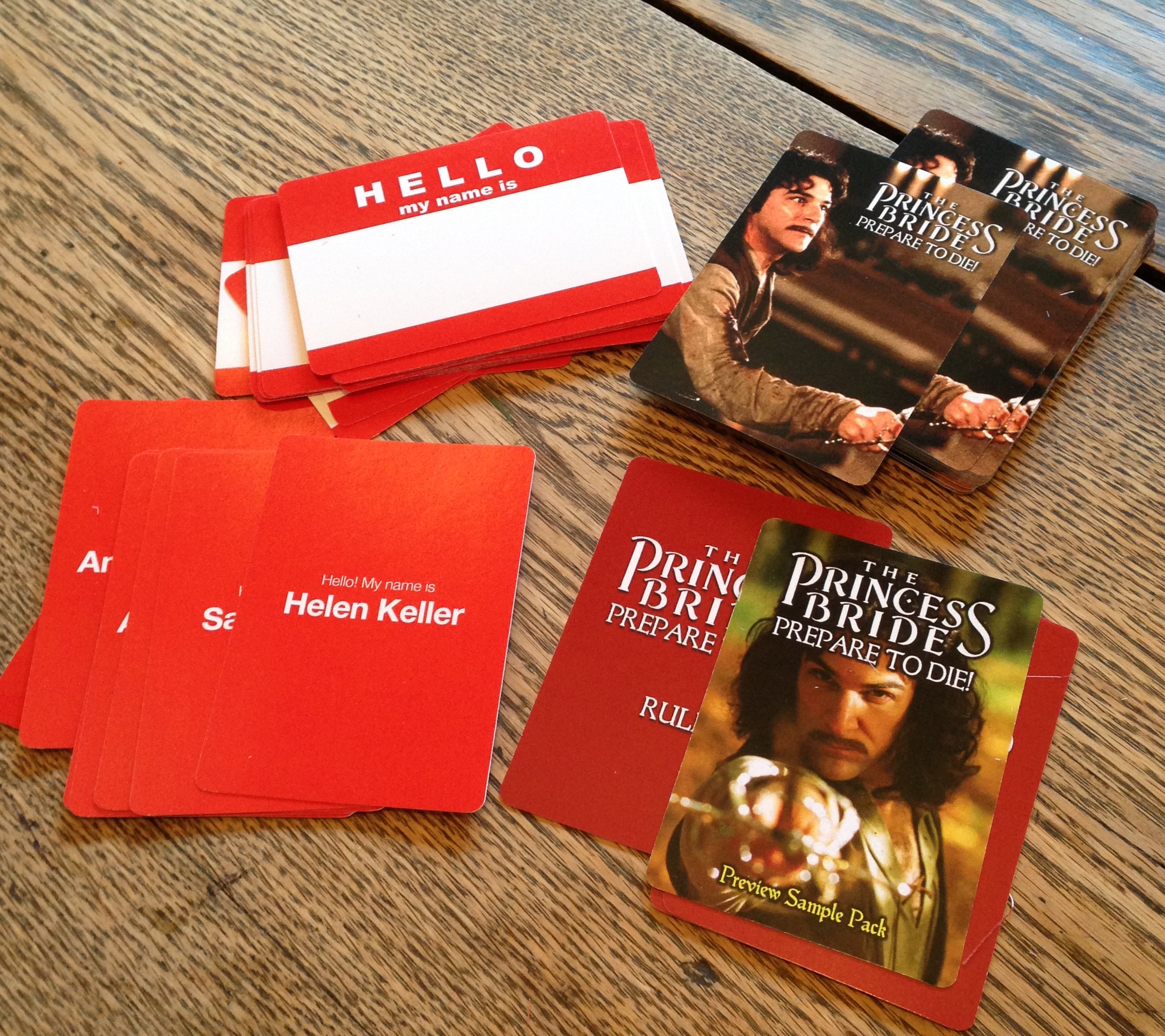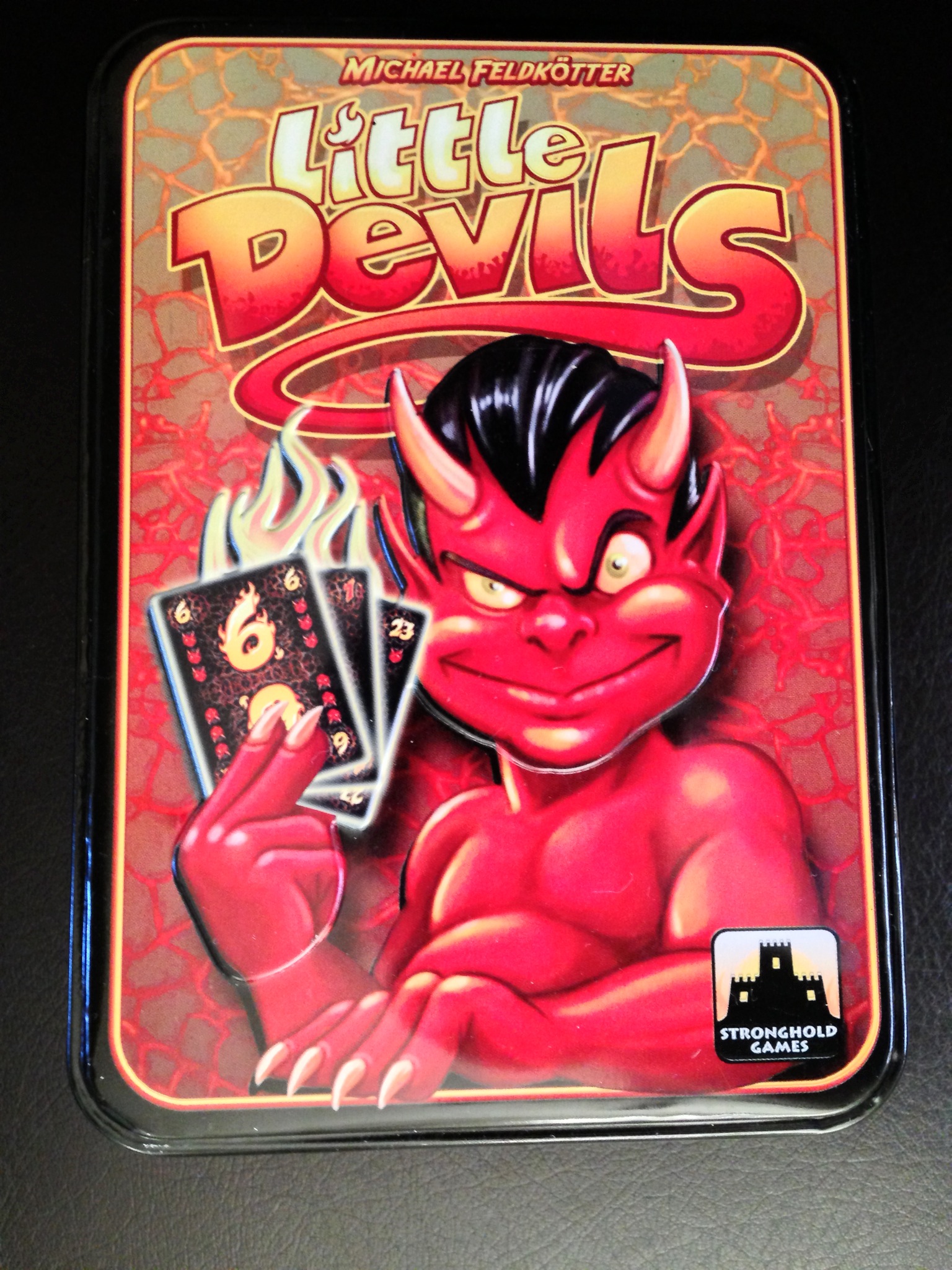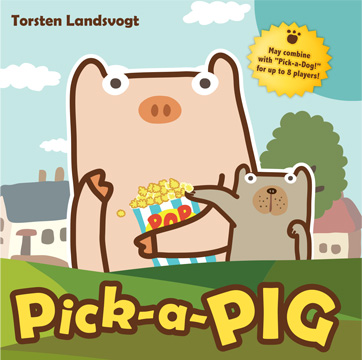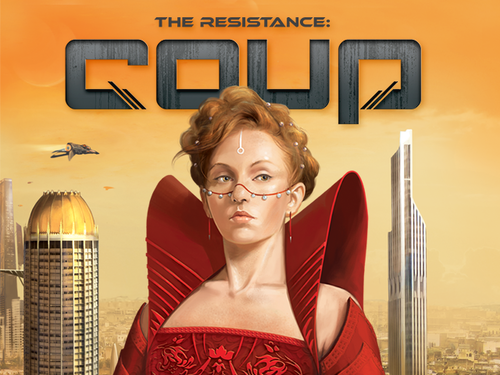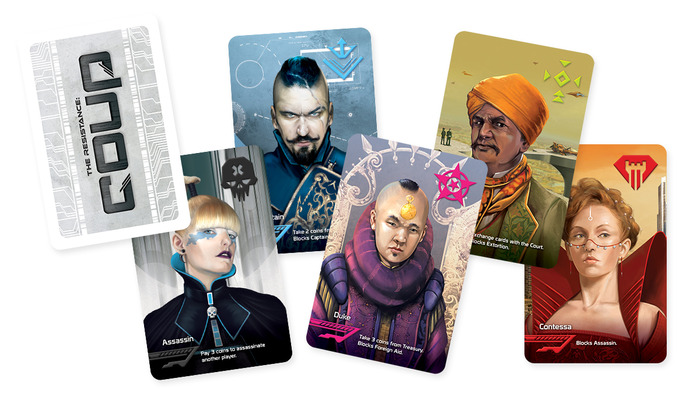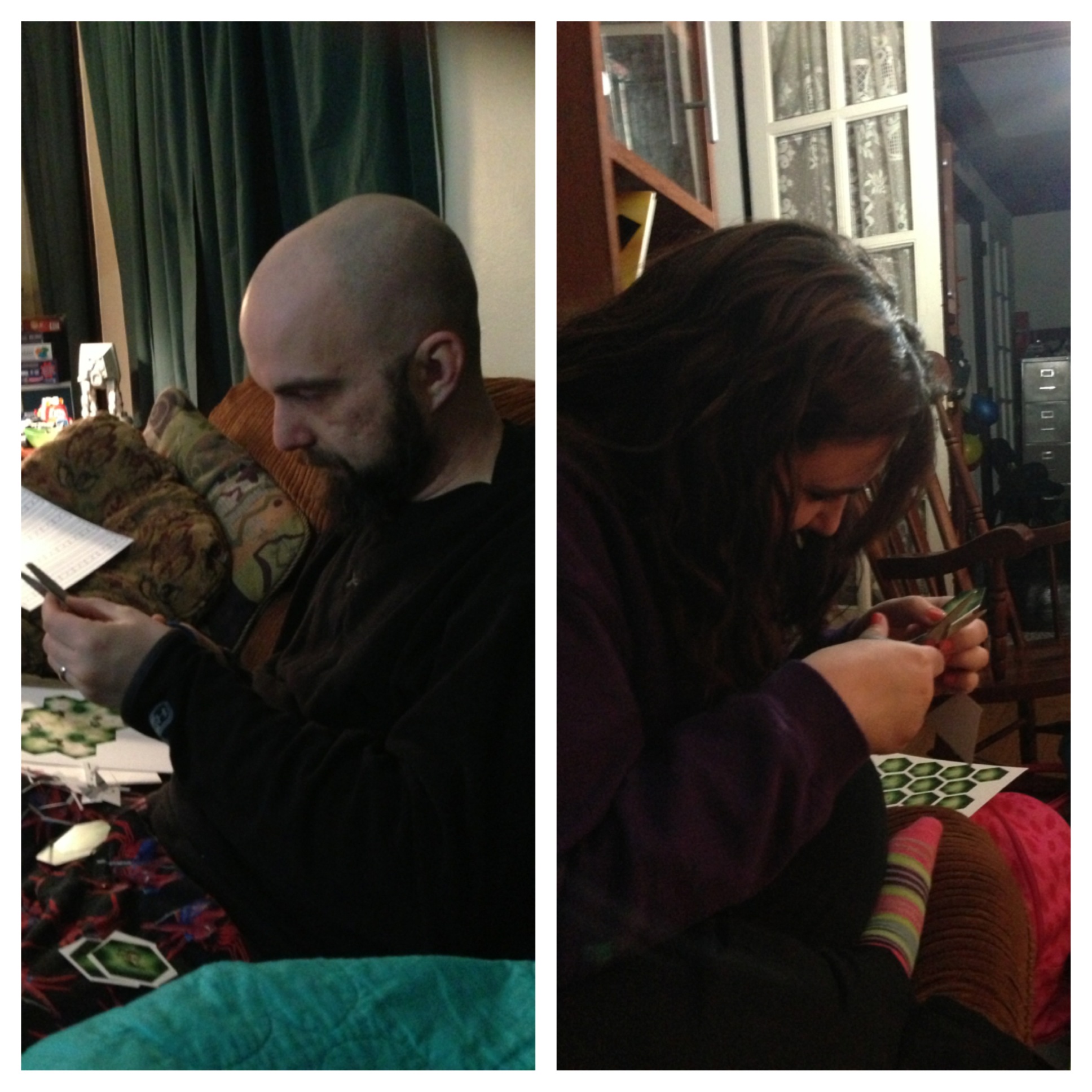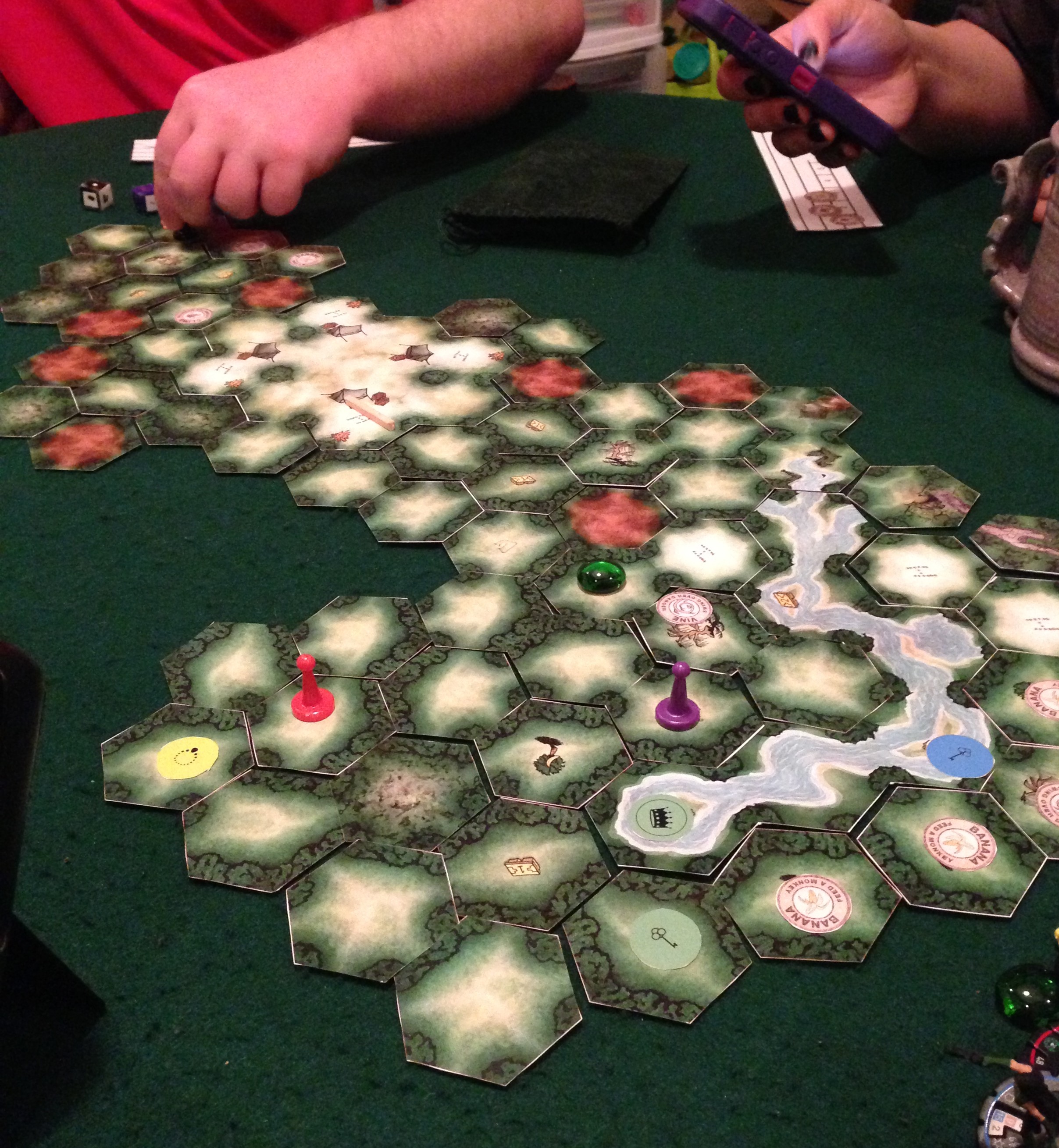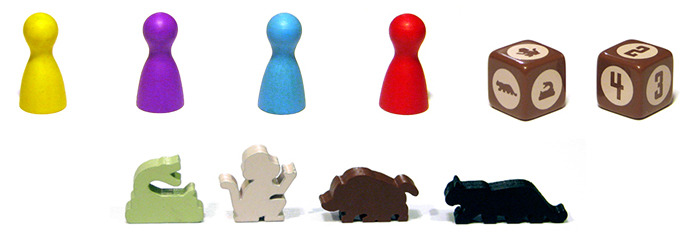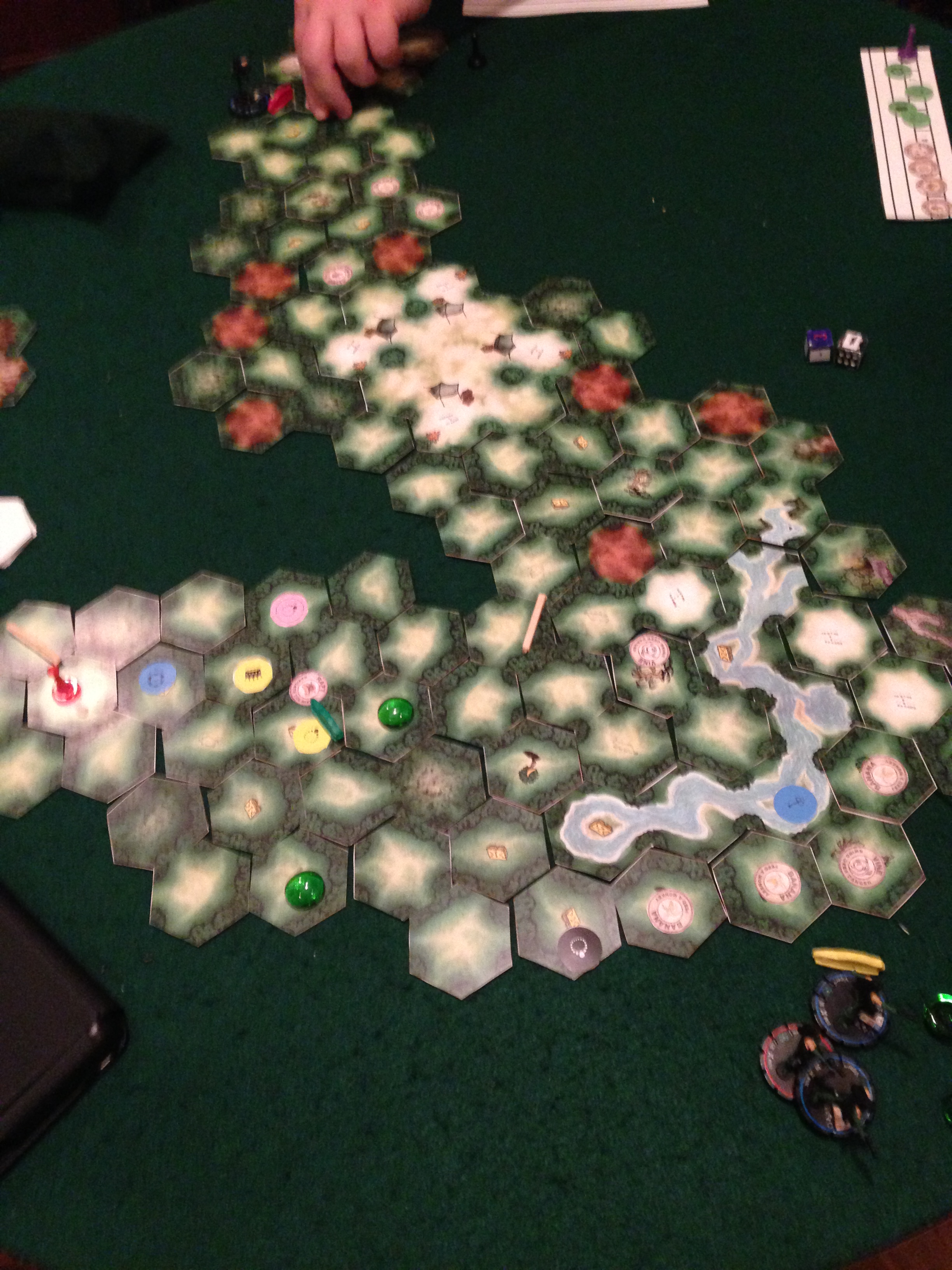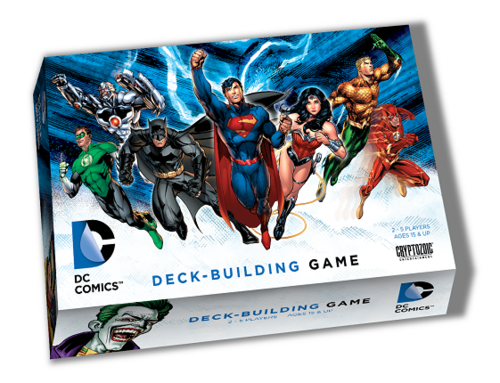 Marvel! DC!
Superman! Batman!
Marvel! DC!
Superman! Batman!
Comic books are a beloved part of Geekdom. And with the release of the DC Comics Deck-Building Game, both major publishing houses have a player in the deck-building genre of board games.
So how does Cryptozoic Entertainment's DC game stack up? Let's find out!
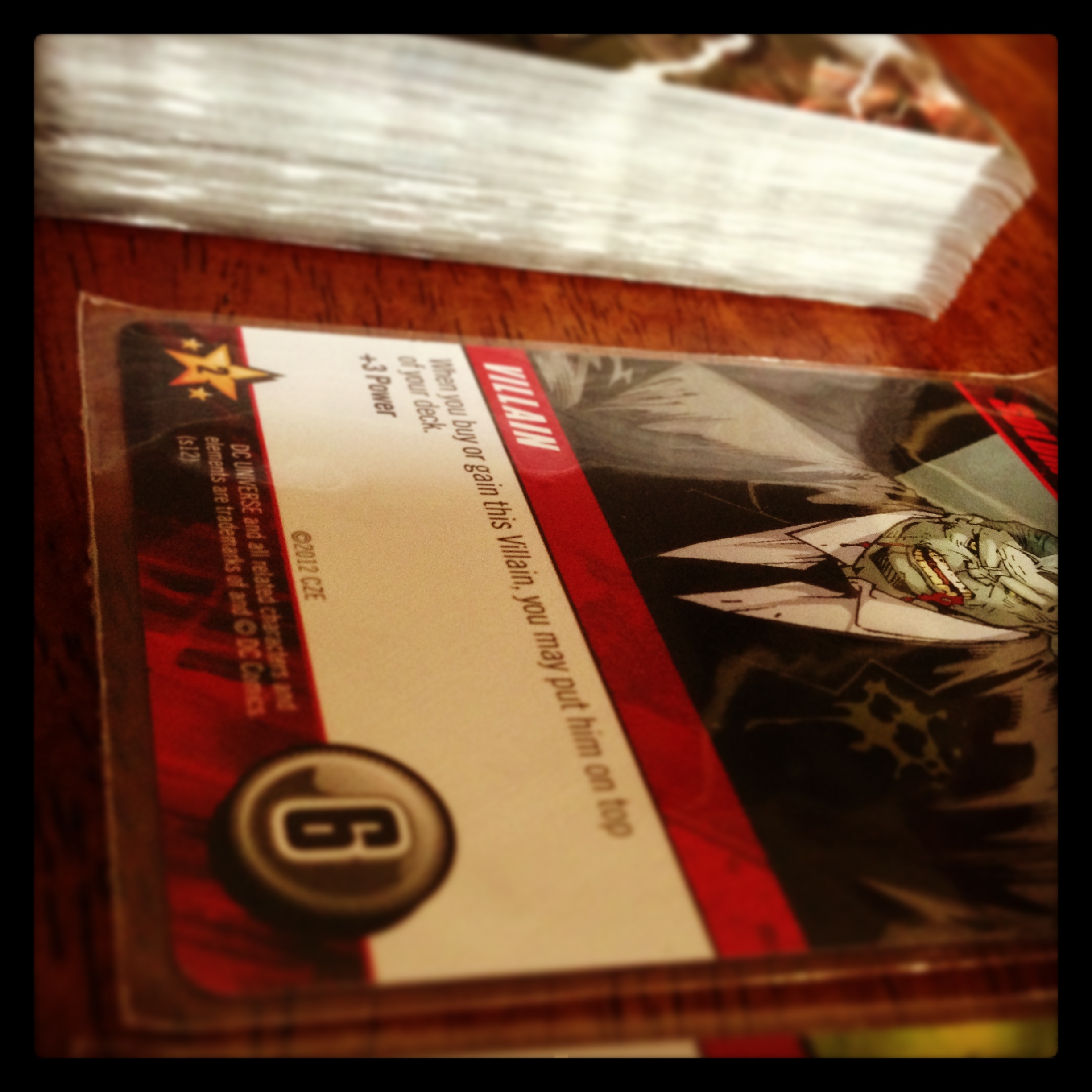 Components
Components
214 cards—Standard-sized cards.
7 Super Hero Cards—These are oversized cards
A word about the insert. They tried really hard to make it useful, but it falls short. The space for the Hero Cards has grooves in it for you to slide your fingers down and get the cards out easily. Yay! Except the grooves don't go all the way down to where the cards are, so it's not helpful at all in actually getting the cards out. Also, the slots for the regular cards are so tight that once I (Firestone) had sleeved the cards, they didn't fit in there anymore. I was able to move some things around and make it all work. I do appreciate them trying to make a not-terrible insert, though...
Setup
One of my complaints about Legendary is how stinking long it takes to set it up. It's the same reason I'm mostly lukewarm about playing Dominion anymore: I'm just not sure it's worth the hassle. The setup here is easy breezy. You shuffle up the Super Hero Cards and give one to each player (or you can allow people to choose their own). Then you give each person their starting hand of crappy cards—7 Punch cards (each gives you 1 Power [the game's lone currency]), and 3 Vulnerability cards (which give you jack squat, and gum up your hand). You set out the Kick cards (1 Power and 1 VP), Weakness cards (-1 VP), and then set up the Super-villians deck (this will vary depending on the number of players). Finally, you shuffle up the giant stack of regular cards, deal out five into a row, and you're ready to go.
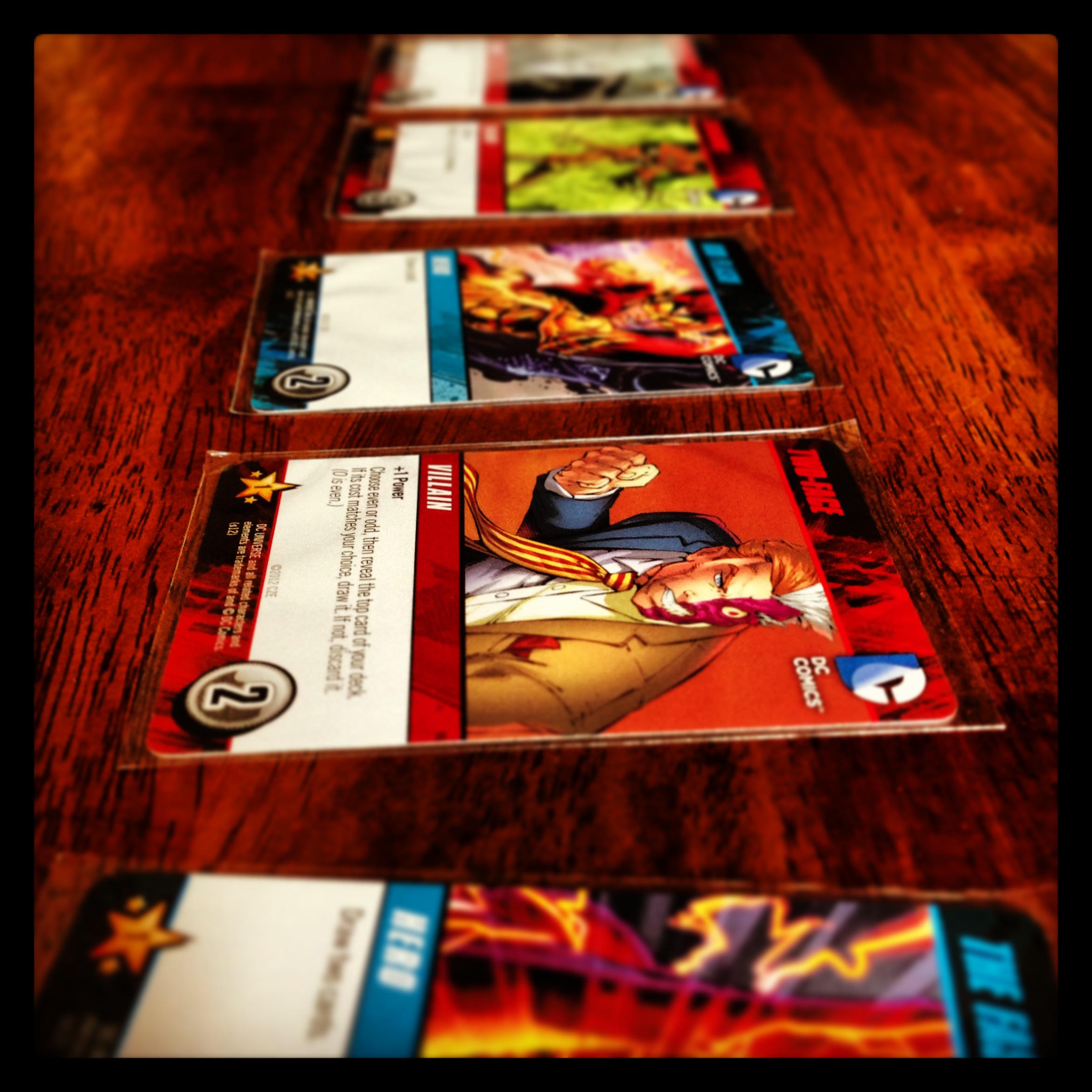 Gameplay
Gameplay
The game has one currency: Power. You draw five cards, add up the Power, and buy stuff...err...defeat stuff...err...it depends. There are Villain cards, Hero cards, Superpower cards, Equipment cards, and Location cards. These all function the same way (giving you Power and sometimes letting you do other cool things), despite the different names. So you're buying Equipment or defeating Villains, all with the same Power. It's not the strongest thematic tie-in, but it's fine. You can buy as many cards as you want on your turn, but the cards in the line-up aren't replenished until the end of the turn. You also have the option to defeat the top Super-villain. Ra's Al Ghul always starts on top, but beyond that, they're random, from a set of 12.
You start the game with one Super Hero identity, and each has a different special ability that is available to use each turn. So Batman's ability gives you +1 Power for each Equipment card you play on a turn—Superman's similar, but substitute Super Power card for Equipment. Wonder Woman lets you draw an extra card at the end of any turn you buy or gain a Villain card. And Aquaman lets you put any cards with a cost of 5 or less that you gain on a turn on top of our deck rather than in your discard. They're fun, and they tried to be thematic with them.
Just like most deck-builders, everything you buy goes into your discard, and you draw five new cards. Then you replenish any cards you bought from the lineup, and if you defeated a Super-villain, you reveal the next one. Every one besides Ra's has a First Appearance attack, which means that as soon as you flip that Super-Villain over, it will attack each player. Parallax makes you discard all cards in your hand with a cost less than 2. Captain Cold makes you flip your Super Hero card facedown until he's defeated. And so forth. Once these guys are defeated, they go into your deck and they have powers they add just like any other card.
Many of the Villain cards will just give you some sort of Power boost once they're in your deck. Some of them also have an Attack, so when you play them, every other player is attacked, unless they have a card that says Defense. For some of the Villains they tried to do some thematically cool things—for instance, Scarecrow's Attack gives other players a Weakness card. Two-Face lets you choose even or odd, draw the top card of your draw deck, and if its cost matches your guess, you get to draw it—if not, you discard it. I think they could have tried to make a few more tie-ins—like having Solomon Grundy have one power if you're playing on a Monday, Wednesday, Friday, or Sunday, and a whole other power if it's a Tuesday, Thursday, or Saturday. But that's a small thing.
Hero, Equipment, and Super Power cards are straightforward, and usually there are combos that work well together. So Batman and Wonder Woman and Robin usually work better with Equipment cards, and Superman with Super Powers. Cards with Flash on them let you draw cards and run through your deck faster. The thematic tie-ins make sense.
One last card is the Location. You play this down in front of you and it has an ongoing effect—usually it lets you draw a card the first time you play a [Villain, Super Power, Equipment, etc] card, depending on which Location it is.
The game ends when either:
- You can't refill all five slots in the lineup—I've never seen this happen.
- You defeat all of the Super-Villains.
Count up VPs, and declare a winner!
Recommendations
Youth group game? Maybe! it's certainly accessible enough, but it's not a large-group game.
Family game? Possibly! Older kids (probably 8 and up) will enjoy it, but it leaves the younger ones in the dust. And there's no way our wives are playing this one!
Gamers' game? Yes! Provided they're open to another deckbuilder—and one that's lighter than most. There's some good gaming to be had with this one.
 The Verdict
The Verdict
Firestone—I have to get this out of the way: Why wouldn't they try to come up a with a better name?! That's like naming Village, The Medieval-Times Worker-Placement Game.
Jeremiah—I agree, the name is pretty utilitarian. If it was a horrible game, it would be one more thing to pile on, but the game is good so I'm willing to overlook it.
Jeremiah—The components are great; in all reality it's pretty hard to screw up a bunch of cards. I haven't sleeved mine yet, so I don't have any problems with the tray insert, except the Super Hero cards do slide all the way down into the abyss.
Firestone—I used this to teach my 8-year-old how to play deck-builders, and it's PERFECT for that. It's straightforward, easy to understand, thematically fun, and just...perfect. He loves it, and it's his go-to game right now.
Jeremiah—I thought the gameplay was great! It's really quite easy to learn, and after you've played it once or twice you start to see the synergy between many of the cards and can really combo up. I love that it supports up to 5 players as well.
Jeremiah—I really like how there's a competitive edge to the game, and I think that comes from how the "line-up" works. Instead of the standard format of many deck-builders (cough, cough Dominion) you only have access to cards for a brief period of time, so I found myself trying to not show much interest in cards in hopes it wouldn't get bought up before my turn came around.
Firestone—Yeah, and unlike some other games with line-ups, things don't stall out in this one—you always have something to do. It was fun playing with my son, because I could always tell when he really wanted a certain card. Super cute...but a terrible poker player.
Jeremiah—There are a few thematic elements that don't make complete sense. Such why the other heroes (players) are referred to as "foes" on the cards, and as mentioned above, Superman wouldn't drive the Batmobile. But for me, they were minor hurdles to overcome on the way to enjoying a really fun game. The fact is, when you shuffle up a couple hundred cards together, wacky stuff is going to happen. Just roll with it.
Firestone—There are a couple of things I found slightly problematic. A few of the cards seem very, very strong. The Super-Villain Parallax lets you double your Power on the turn you play him. And the Man Of Steel card gives you +3 Power and lets you put all Super Powers from your discard pile into your hand—depending on when that comes up, you'll be able to destroy just about anything. Those cards are expensive, but in my experience, if you get Parallax—especially early—you'll just roll. Given the weight of the game, though, I'm generally okay with it.
My other small complaint is that the game usually rushes toward the end. People get such powerful decks by the end that someone on each turn is defeating a Super-Villain. But that means the Super-Villains on the bottom of that deck won't ever get played because the game will end before they can cycle through. The designer recently addressed this by offering a variant where the Super-Villains are shuffled into the main deck, you have six cards in the line-up instead of five, and the game's not over until you go through the whole deck. I can't wait to try that out—seems fun!
We should probably also mention the women in the game. Almost all of them are showing a fair amount of cleavage. This is standard comic-book fare, but if my son has a hand filled with Wonder Woman, Poison Ivy, and the Suicide Squad, he's going to be staring at a lot of cartoon cleavage. It's not a deal-breaker but it is disappointing.
Firestone Final Thoughts—The combos are cool. The theme is well-integrated. I can't think of a better intro to deck-builders. The art is terrific. And above all, it's FUN. If you have kids who like superheroes and dislike being bored (Dominion...Zzzzz....), get this game!
Jeremiah Final Thoughts— This game is working its way into a pretty regular rotation among my gamer friends. One of them referred to it as "my jam" a week ago. It's a really fun game, and at its core it's pretty easy to learn—but offers plenty of depth for strategies and card combos. I'm giving this one a big thumbs up!
Theology Of Games would like to thank Cryptozoic Entertainment for providing a review copy of the DC Comics Deck-Building Game. This in no way affected our opinion of the game.
Thanks for reading, and we would be so grateful if you would join us on Facebook, Twitter, and Instagram, and if you would subscribe to the blog over on the right! —->
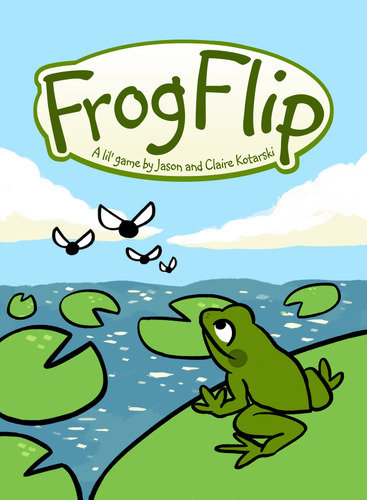 Jason Kotarski is a busy guy. He's a husband, and a dad, and a church planter, and a musician, and a game designer. His first published game—The Great Heartland Hauling Company—is a cool pick-up-and-deliver game. He was kind enough to let us interview him, too. He's got a new little 2-player card game in the works, and we're going to give you our impressions of FrogFlip.
Components
Jason Kotarski is a busy guy. He's a husband, and a dad, and a church planter, and a musician, and a game designer. His first published game—The Great Heartland Hauling Company—is a cool pick-up-and-deliver game. He was kind enough to let us interview him, too. He's got a new little 2-player card game in the works, and we're going to give you our impressions of FrogFlip.
Components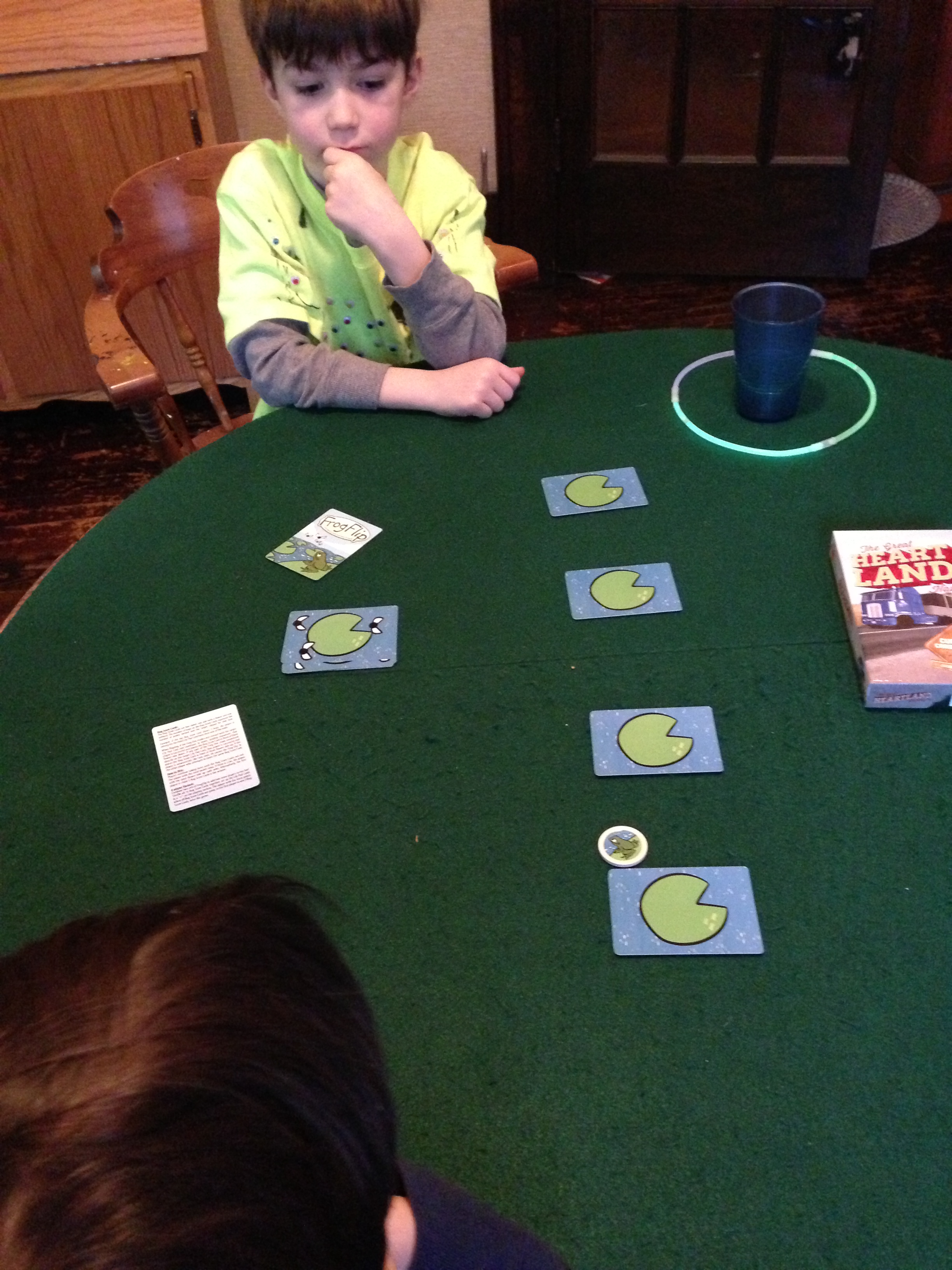 Each of the Bug Score cards has a number of bugs on it—either one, two, three, or four of them. On their turn, each player will attempt to flip the frog to the Lily Pad card that corresponds to the number of bugs on the top card of the Bug Score stack. So if there are two bugs on the top card, I'm trying to flip the frog onto the Lily Pad card that's two away from me. If I miss, my opponent is trying to flip the frog onto the Lily Pad card that's two away from her.
Each of the Bug Score cards has a number of bugs on it—either one, two, three, or four of them. On their turn, each player will attempt to flip the frog to the Lily Pad card that corresponds to the number of bugs on the top card of the Bug Score stack. So if there are two bugs on the top card, I'm trying to flip the frog onto the Lily Pad card that's two away from me. If I miss, my opponent is trying to flip the frog onto the Lily Pad card that's two away from her.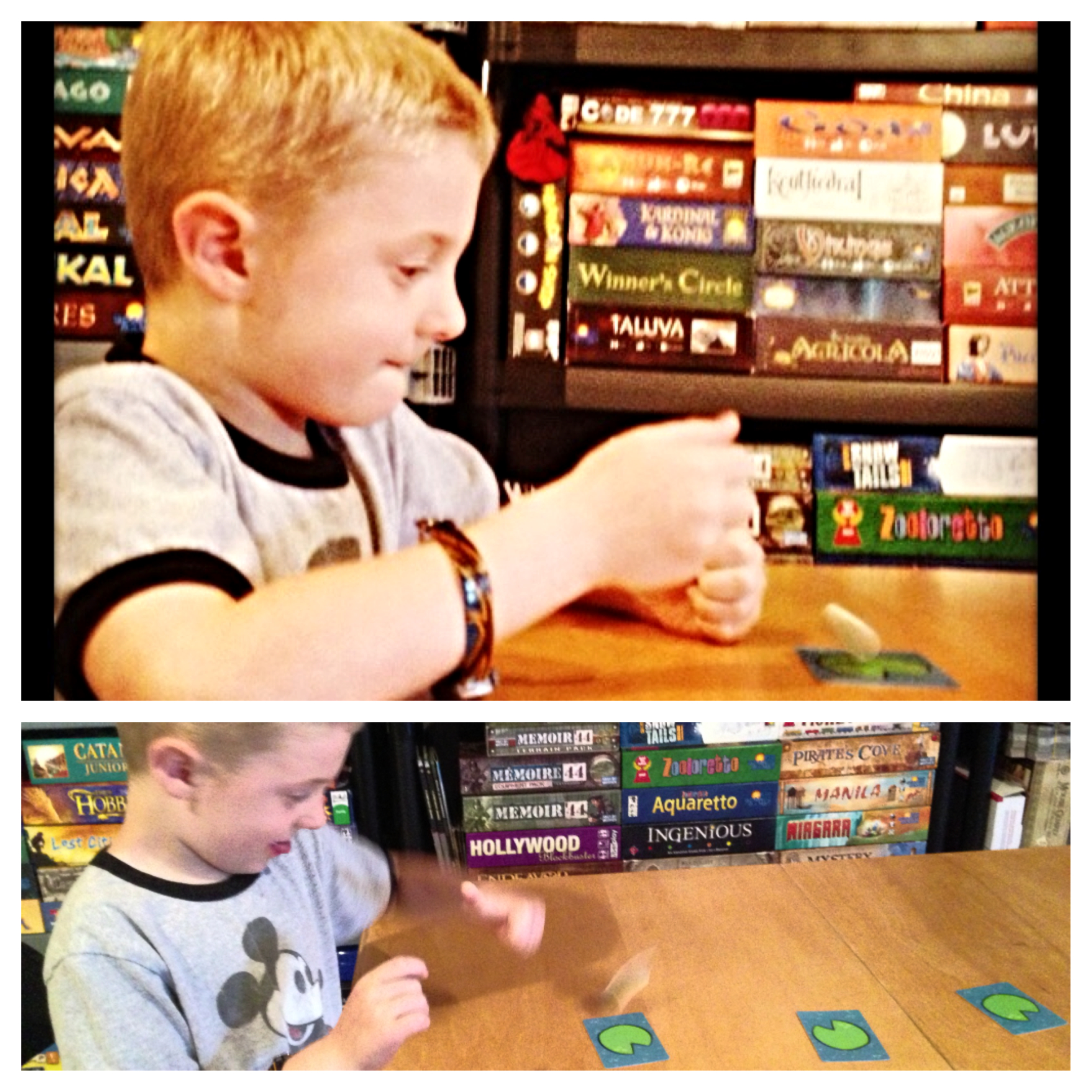 Firestone's Final Verdict—This is an adorable little family game. I fear it has a very short window where it will continue to interest my boys, but I'll happily play it until that window closes.
Firestone's Final Verdict—This is an adorable little family game. I fear it has a very short window where it will continue to interest my boys, but I'll happily play it until that window closes.